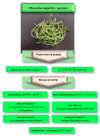Novel Insights into Phaseolus vulgaris L. Sprouts: Phytochemical Analysis and Anti-Aging Properties
- PMID: 38999009
- PMCID: PMC11243055
- DOI: 10.3390/molecules29133058
Novel Insights into Phaseolus vulgaris L. Sprouts: Phytochemical Analysis and Anti-Aging Properties
Abstract
Skin aging is an inevitable and intricate process instigated, among others, by oxidative stress. The search for natural sources that inhibit this mechanism is a promising approach to preventing skin aging. The purpose of our study was to evaluate the composition of phenolic compounds in the micellar extract of Phaseolus vulgaris sprouts. The results of a liquid chromatography-mass spectrometry (LC-MS) analysis revealed the presence of thirty-two constituents, including phenolic acids, flavanols, flavan-3-ols, flavanones, isoflavones, and other compounds. Subsequently, the extract was assessed for its antioxidant, anti-inflammatory, anti-collagenase, anti-elastase, anti-tyrosinase, and cytotoxic properties, as well as for the evaluation of collagen synthesis. It was demonstrated that micellar extract from common bean sprouts has strong anti-aging properties. The performed WST-8 (a water-soluble tetrazolium salt) assay revealed that selected concentrations of extract significantly increased proliferation of human dermal fibroblasts compared to the control cells in a dose-dependent manner. A similar tendency was observed with respect to collagen synthesis. Our results suggest that micellar extract from Phaseolus vulgaris sprouts can be considered a promising anti-aging compound for applications in cosmetic formulations.
Keywords: Fabaceae; LC-MS; Phaseolus; antioxidant activity; collagen synthesis; cytotoxicity; phenolic compounds; sprouts.
Conflict of interest statement
The authors declare no conflicts of interest.
Figures




Similar articles
-
Black Bean (Phaseolus vulgaris L.) Polyphenolic Extract Exerts Antioxidant and Antiaging Potential.Molecules. 2021 Nov 6;26(21):6716. doi: 10.3390/molecules26216716. Molecules. 2021. PMID: 34771125 Free PMC article.
-
Phenolic composition, antioxidant, anti-wrinkles and tyrosinase inhibitory activities of cocoa pod extract.BMC Complement Altern Med. 2014 Oct 7;14:381. doi: 10.1186/1472-6882-14-381. BMC Complement Altern Med. 2014. PMID: 25292439 Free PMC article.
-
Antiadhesive activity of hydroethanolic extract from bean pods of Phaseolus vulgaris (common bean) against uropathogenic E. coli and permeability of its constituents through Caco-2 cells monolayer.J Ethnopharmacol. 2021 Jun 28;274:114053. doi: 10.1016/j.jep.2021.114053. Epub 2021 Mar 19. J Ethnopharmacol. 2021. PMID: 33746003
-
Protective, Anti-Inflammatory, and Anti-Aging Effects of Soy Isoflavones on Skin Cells: An Overview of In Vitro and In Vivo Studies.Molecules. 2024 Dec 7;29(23):5790. doi: 10.3390/molecules29235790. Molecules. 2024. PMID: 39683947 Free PMC article. Review.
-
Bioactive Compounds from Medicinal Plants as Potential Adjuvants in the Treatment of Mild Acne Vulgaris.Molecules. 2024 May 19;29(10):2394. doi: 10.3390/molecules29102394. Molecules. 2024. PMID: 38792254 Free PMC article. Review.
References
-
- Pukalskienė M., Venskutonis P.R., Pukalskas A. Phytochemical composition and antioxidant properties of Filipendula vulgaris as a source of healthy functional ingredients. J. Funct. Foods. 2015;15:233–242. doi: 10.1016/j.jff.2015.03.002. - DOI
-
- Ribeiro A.S., Estanqueiro M., Oliveira M.B., Sousa Lobo J.M. Main benefits and applicability of plant extracts in skin care products. Cosmetics. 2015;2:48–65. doi: 10.3390/cosmetics2020048. - DOI
-
- Oyelude E.O., Gli N.P., Amafo J. Proximate, mineral and anti-nutrient composition of Phaseolus vulgaris leaf. J. Sci. Innov. Dev. 2012;1:12–21.
-
- Nimse S.B., Pal D. Free radicals, natural antioxidants, and their reaction mechanisms. RSC Adv. 2015;5:27986–28006. doi: 10.1039/C4RA13315C. - DOI
MeSH terms
Substances
LinkOut - more resources
Full Text Sources
Medical

